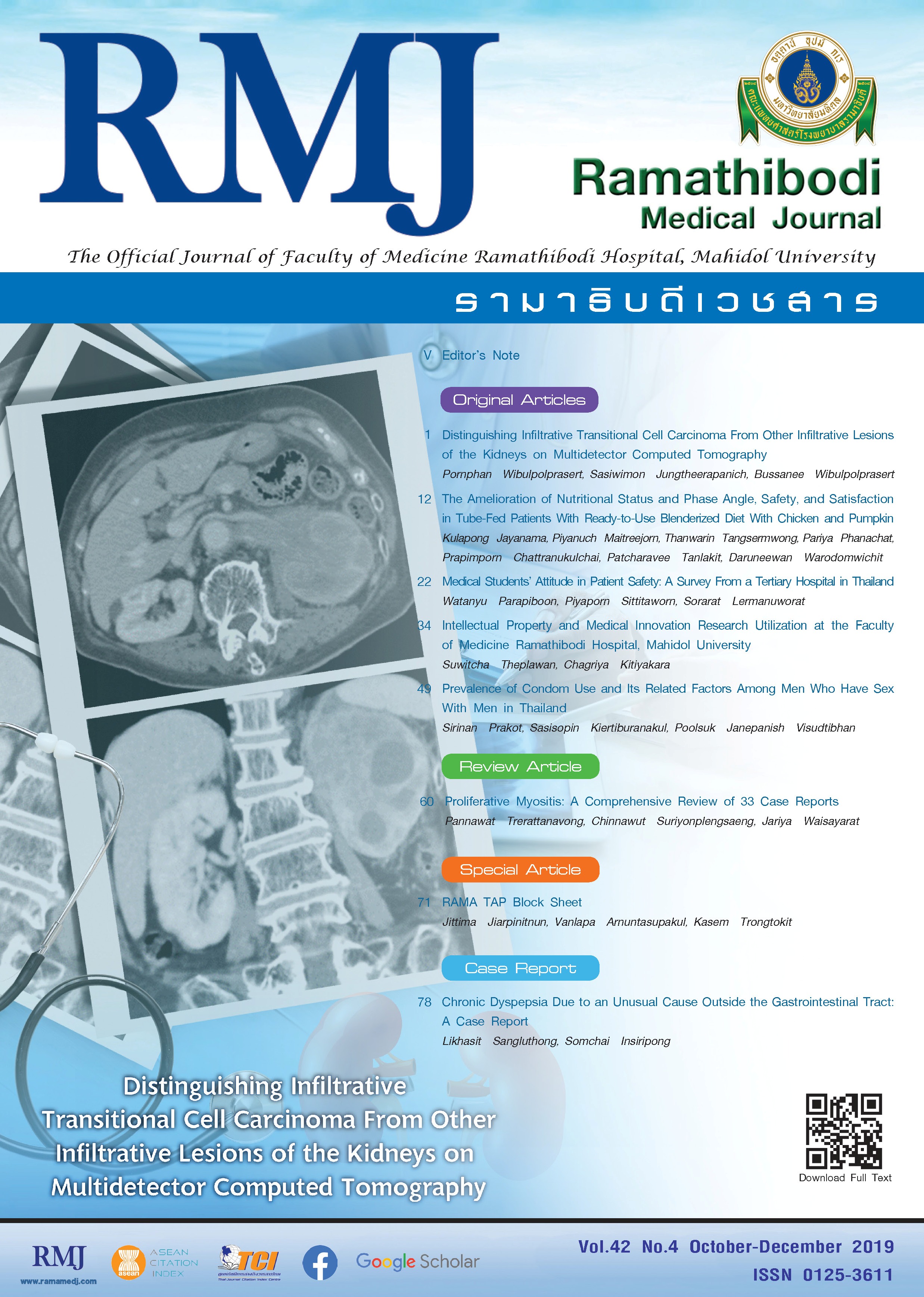ทัศนคติของนักศึกษาแพทย์ชั้นคลินิกโรงพยาบาลศูนย์ระดับตติยภูมิต่อวัฒนธรรมความปลอดภัยของผู้ป่วย
Main Article Content
บทคัดย่อ
บทนำ: การเข้าใจวัฒนธรรมความปลอดภัยของผู้ป่วยในมุมมองของนักศึกษาแพทย์เป็นสิ่งสำคัญและสามารถนำไปใช้ประโยชน์ในการพัฒนาการเรียนการสอนเรื่องความปลอดภัยของผู้ป่วยได้
วัตถุประสงค์: เพื่อศึกษาทัศนคติของนักศึกษาแพทย์ชั้นคลินิกต่อความปลอดภัยของผู้ป่วย
วิธีการศึกษา: การวิจัยเชิงสำรวจแบบตัดขวางในนักศึกษาแพทย์ชั้นปีที่ 4 - 6 ณ โรงพยาบาลมหาราชนครราชสีมา ระหว่างเดือนสิงหาคม พ.ศ. 2561 ถึงเดือนกันยายน พ.ศ. 2561 โดยใช้แบบสอบถามทัศนคติความปลอดภัยของผู้ป่วย จำนวน 26 ข้อย่อย (26-item Attitudes toward Patient Safety Questionnaire-III, APSQ-III) ถูกส่งให้ตอบแบบไม่ระบุตัวตนโดยสมัครใจผ่านแบบฟอร์มออนไลน์ Google Forms เพื่อรวบรวมและวิเคราะห์วัฒนธรรมความปลอดภัยของผู้ป่วยใน 9 หัวข้อหลัก
ผลการศึกษา: นักศึกษาแพทย์ จำนวน 106 คน จากจำนวนทั้งหมด 128 คน เข้าร่วมตอบแบบสอบถาม ใน 9 หัวข้อหลักของวัฒนธรรมความปลอดภัยของผู้ป่วยพบว่า นักศึกษาแพทย์มีทัศนคติด้านบวกสูงสุดในหัวข้อชั่วโมงการทำงานที่มากเป็นสาเหตุของการเกิดความผิดพลาด คิดเป็นร้อยละ 76.1 และทัศนคติด้านบวกน้อยที่สุดในหัวข้อความไม่เป็นมืออาชีพของแต่ละบุคคลเป็นสาเหตุของความผิดพลาด คิดเป็นร้อยละ 26.9 โดยคะแนนทัศนคติด้านบวกต่อความปลอดภัยของผู้ป่วยไม่มีความสัมพันธ์กับชั้นปีหรือคะแนนเกรดเฉลี่ยของนักศึกษาแพทย์แต่อย่างใด และครึ่งหนึ่งของนักศึกษาแพทย์เห็นความสำคัญของการเรียนเรื่องความปลอดภัยของผู้ป่วยในหลักสูตรแพทยศาสตรบัณฑิต
สรุป: นักศึกษาแพทย์มีทัศนคติด้านบวกต่อความปลอดภัยของผู้ป่วย จึงควรเน้นย้ำเรื่องมุมมองเชิงระบบของความผิดพลาดในการสอนนักศึกษาแพทย์เรื่องความปลอดภัยของผู้ป่วย
Article Details
All articles are distributed by the Creative Commons Attribution (CC BY-NC-ND) license. Copyright © 2024 by the Authors. Licensee RMJ, Faculty of Medicine Ramathibodi Hospital, Mahidol University, Bangkok, Thailand.
References
Grober ED, Bohnen JM. Defining medical error. Can J Surg. 2005;48(1):39-44.
Abd Elwahab S, Doherty E. What about doctors? The impact of medical errors. Surgeon. 2014;(6):297-300. doi:10.1016/j.surge.2014.06.004.
Weaver SJ, Lubomksi LH, Wilson RF, Pfoh ER, Martinez KA, Dy SM. Promoting a culture of safety as a patient safety strategy: a systematic review. Ann Intern Med. 2013;158(5 Pt 2):369-374. doi:10.7326/0003-4819-158-5-201303051-00002.
Kachalia A. Improving patient safety through transparency. N Engl J Med. 2013;369(18):1677-1679. doi:10.1056/NEJMp1303960.
Kohn LT, Corrigan JM, Donaldson MS, eds. To Err Is Human: Building a Safer Health System. Committee on Quality of Health Care in America, Institute of Medicine. Washington, DC: National Academy Press; 2000. https://books.nap.edu/catalog/9728.html. Accessed April 4, 2019.
Oates K, Wilson I, Hu W, Walker B, Nagle A, Wiley J. Changing medical student attitudes to patient safety: a multicentre study. BMC Med Educ. 2018;18(1):205. doi:10.1186/s12909-018-1313-0.
Wetzel AP, Dow AW, Mazmanian PE. Patient safety attitudes and behaviors of graduating medical students. Eval Health Prof. 2012;35(2):221-238. doi:10.1177/0163278711414560.
Carruthers S, Lawton R, Sandars J, Howe A, Perry M. Attitudes to patient safety amongst medical students and tutors: developing a reliable and valid measure. Med Teach. 2009;31(8):e370-e376.
Google. Google Forms. https://www.google.com/forms. Accessed April 4, 2019.
Walton M, Woodward H, Van Staalduinen S, et al. The WHO patient safety curriculum guide for medical schools. Qual Saf Health Care. 2010;19(6):542-546. doi:10.1136/qshc.2009.036970.
Reason J. Human error: models and management. BMJ. 2000;320(7237):768-770. doi:10.1136/bmj.320.7237.768.
Wong KC. Using an Ishikawa diagram as a tool to assist memory and retrieval of relevant medical cases from the medical literature. J Med Case Rep. 2011;5:120. doi:10.1186/1752-1947-5-120.
Braithwaite J, Herkes J, Ludlow K, Lamprell G, Testa L. Association between organisational and workplace cultures, and patient outcomes: systematic review protocol. BMJ Open. 2016;6(12):e013758. doi:10.1136/bmjopen-2016-013758.
Liu H, Li Y, Zhao S, et al. Perceptions of patient safety culture among medical students: a cross-sectional investigation in Heilongjiang Province, China. BMJ Open. 2018;8(7):e020200. doi:10.1136/bmjopen-2017-020200.
Leung GK, Ang SB, Lau TC, Neo HJ, Patil NG, Ti LK. Patient safety culture among medical students in Singapore and Hong Kong. Singapore Med J. 2013;54(9):501-505. doi:10.11622/smedj.2013172.




